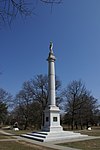National Park, New Jersey
1902 establishments in New JerseyBorough form of New Jersey governmentBoroughs in Gloucester County, New JerseyNational Park, New JerseyPopulated places established in 1902 ... and 2 more
Use American English from May 2020Use mdy dates from May 2020

National Park is a borough in Gloucester County, New Jersey, United States. As of the 2010 United States Census, the borough's population was 3,036, reflecting a decline of 169 (−5.3%) from the 3,205 counted in the 2000 Census, which had in turn declined by 208 (−6.1%) from the 3,413 counted in the 1990 Census. Despite its name, National Park is neither a national park nor associated with one. The borough had the 18th-highest property tax rate in New Jersey, with an equalized rate of 4.446% in 2020, compared to 3.212% in the county as a whole and a statewide average of 2.279%.
Excerpt from the Wikipedia article National Park, New Jersey (License: CC BY-SA 3.0, Authors, Images).National Park, New Jersey
Lakehurst Avenue,
Geographical coordinates (GPS) Address Nearby Places Show on map
Geographical coordinates (GPS)
| Latitude | Longitude |
|---|---|
| N 39.867297 ° | E -75.185621 ° |
Address
Lakehurst Avenue 303
08063
New Jersey, United States
Open on Google Maps






